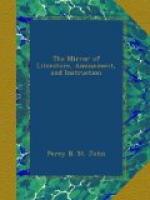Simplicity and imposing expression seem to have hitherto
formed the principal objects of his pursuit; but the
distinction between the simple and rude, the powerful
and the exaggerated, is not always observed in the
labours of the Dane. His simplicity is sometimes
without grace; the impressive—austere,
and without due refinement. The air and contours
of his heads, except, as in the Mercury—an
excellent example both of the beauties and defects
of the artist’s style—when immediately
derived from antiquity, though grand and vigorous,
seldom harmonize in the principles of these efforts
with the majestic regularity of general nature.
The forms, again, are not unfrequently poor, without
a vigorous rendering of the parts, and destitute at
times of their just roundness. These defects
may in some measure have arisen from the early and
more frequent practice of the artist in relievos.
In this department, Thorwaldsen is unexceptionably
to be admired. The Triumph of Alexander, originally
intended for the frieze of the government palace at
Milan, notwithstanding an occasional poverty, in the
materials of thought, is, as a whole, one of the grandest
compositions in the world; while the delicacy of execution,
and poetic feeling, in the two exquisite pieces of
Night and Aurora, leave scarcely a wish here ungratified.
But in statues, Thorwaldsen excels only where the
forms and sentiment admit of uncontrolled imagination,
or in which no immediate recourse can be had to fixed
standards of taste, and to the simple effects of nature.
Hence, of all his works, as admitting of unconfined
expression, and grand peculiarity of composition, the
statues of the Apostles, considered in themselves,
are the most excellent. Thorwaldsen, in fine,
possesses singular, but in some respects erratic genius.
His ideas of composition are irregular; his powers
of fancy surpass those of execution; his conceptions
seem to lose a portion of their value and freshness
in the act of realizement. As an individual artist,
he will command deservedly a high rank among the names
that shall go down to posterity. As a sculptor,
who will influence, or has extended the principles
of the art, his pretensions are not great; or, should
this influence and these claims not be thus limited,
the standard of genuine and universal excellence must
be depreciated in a like degree.—Meme’s
History of Sculpture, &c.
* * * * *
SIGN OF THE TIMES.
One of the singularities of the time is an unwillingness to tell the truth, even when there is no ground for suppressing or perverting it. It is so frequently under or overstated by most persons in this country who speak and write, according to the side they have espoused, or the inclinations and political principles of those by whom they are likely to be read or heard, that they at last persuade themselves there is a sort of impropriety in presenting facts in their proper colours.—Quarterly Review.




